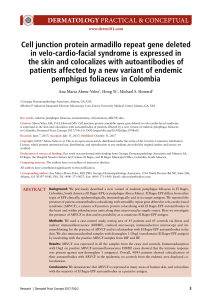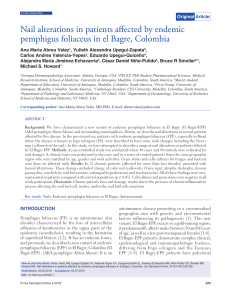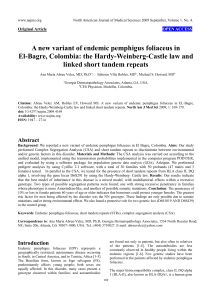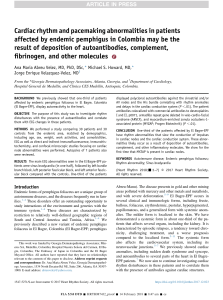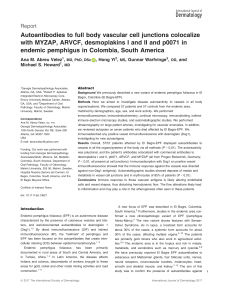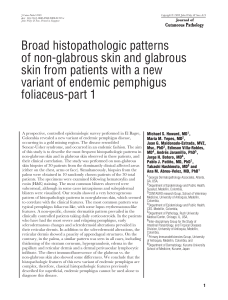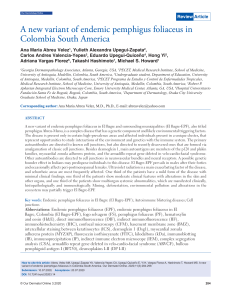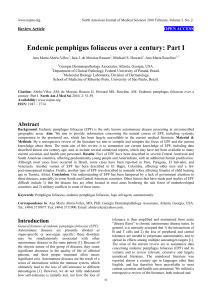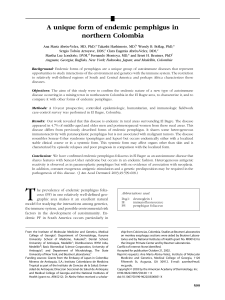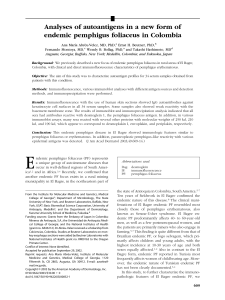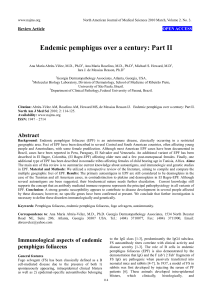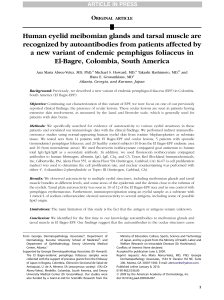El Bagre EPF August 2016
advertisement
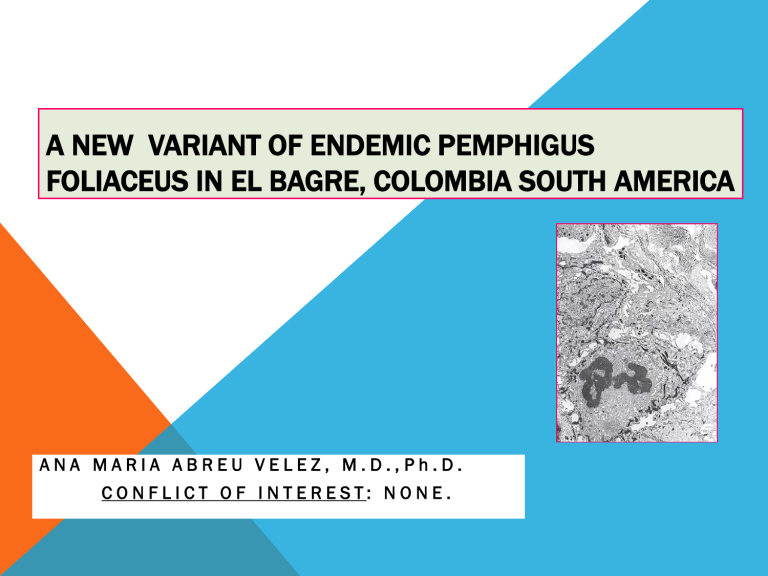
A NEW VARIANT OF ENDEMIC PEMPHIGUS FOLIACEUS IN EL BAGRE, COLOMBIA SOUTH AMERICA ANA MARIA ABREU VELEZ, M.D.,Ph.D. CO NFLICT O F I NTEREST: NO NE. WHAT IS ENDEMIC PEMPHIGUS FOLIACEUS? (EPF) Endemic pemphigus foliaceus (EPF) is the only autoimmune disease in the world restricted to a well-defined geographic region. This makes EPF an excellent model to study the interaction between genetics, the environment and the immune system. There are two forms of pemphigus foliaceus: a nonendemic form, first described in Paris in 1844, that occurs throughout the world, and an endemic form known as fogo selvagem (FS), that was first reported in Brazil around 1903. Other endemic foci have been reported in Colombia, Peru, Venezuela, and Tunisia. The presence of anti–immunoglobulin G (IgG) circulating autoantibodies and in situ autoantibodies was described in patients with fogo selvagem (FS). These autoantibodies were detected by means of indirect and direct immunofluorescence (IF); intracellular staining was demonstrated within the epidermis. The autoantigen related to EPF is desmoglein 1, a 160-kd glycoprotein of the desmosome, targeted by in situ and circulating IgG autoantibodies, mainly of the IgG4 subclass. ENDEMIC PEMPHIGUS FOLIACEUS The endemic form is thought to have an environmental cause. Normal subjects living in an endemic area have antibodies against desmoglein 1. Endemic foci of fogo selvagem are almost exclusively located in rural areas of Brazil. People of many races and ethnic groups are affected, including Brazilians of Portuguese, Spanish, German, African, and Japanese descent who live in the endemic areas. The incidence of fogo selvagem has decreased dramatically. The disease follows the course of streams and creeks and vanishes after urbanization of the endemic areas. ENDEMIC PEMPHIGUS FOLIACEUS These findings support the concept that the production of antibodies against desmoglein 1 is initiated by exposure to an unknown environmental agent. The endemic and non-endemic forms of the disease are clinically, histologically, and immunologically similar; several features are unique to the endemic form, such as the geographic, temporal, and familial clustering of cases, the higher frequency of cases among children and young adults than among older persons, and an association with certain HLA alleles. Bites of black flies, in particular Simulium nigrimanum, may initiate this disorder in Brazil, possibly due to salivary proteins. FOGO SELVAGEM In Brazil, the endemic pemphigus foliaceus is often referred to as fogo selvagem(FS). It primarily affects children and young adults, with the highest incidence rates occurring in the 10 - 30 year old age group. Also, the incidence in men and women appears to be similar. Furthermore, FS cases tend to be clustered in specific families residing in rural areas, especially in workers for road construction and agriculture. It was originally observed in specific river valleys of rural Brazil where deforestation occured for mining, and road construction. A strong association between FS and class II HLA antigens exists. Patients with FS have one or both of the HLA DR1 and DR4 genes, whereas these genes were evident in only 22 (34%) of the 64 control subjects. The HLA-DR1-Dw20 (DRB1*0102) gene is related to susceptibility to FS, whereas absence of the HLA-DQw2 (DQB1*0201) allele is linked with resistance. A NEW VARIANT OF ENDEMIC PEMPHIGUS FOLIACEUS, EL BAGRE-EPF(PEMPHIGUS ABREU-MANU) THAT RESEMBLES SENEAR-USHER SYNDROME. El Bagre-EPF is distinct from other EPF in terms of age of onset and gender. Photosensitivity and a common symptom of severe stinging or burning occurs with ultraviolet (UV) exposure. ENDEMIC FOCI OF PEMPHIGUS FOLIACEUS GEOGRAPHIC LOCALIZATION ENDEMIC AREA ENVIRONMENT ENDEMIC CLUSTERING OF DISEASES INCLUDING AUTOIMMUNE FOLLOWING XENOBIOTIC EXPOSURE. Endemic and epidemic diseases occurring in an acute or chronic manner, in a relatively welldefined restricted geographic area are not uncommon. Examples of such diseases include chronic disease mortality among silicotics in CA. US. Pink disease (acrodynia). Autoimmunity associated with the Minamata Bay Japan disaster and methyl mercury. Generalized disorders of ectodermal tissue following prenatal exposure to polychlorinated biphenyls reported in Taiwan and Japan. The Apallic syndrome, Uric (Kashin-Beck) disease, eosinophilia-myalgia syndrome. Hip disease seen in the Mseleni of Northern Zululand. Handigodu disease in Karnataka, India, Urov disease (osteoarthritis endemic in Siberia and China) and Keshan disease. In USA, the effects of diesel exhaust particulate, poisons by pesticides. High nitrate (organic fertilizers) in the Thornton Well Field, near Woodstock, Ontario, Canada (systemic sclerosis ). Geographical clustering of scleroderma in a rural area in the province of Rome. SOME CLINICAL FORMS SOME ATYPICAL CLINICAL LESIONS SIMILARITIES TO LUPUS ERYTHEMATOSUS TESTING FOR AUTOANTIGENS USING A BACULOVIRUS EXPRESSION SYSTEM Trypsinize Bovine Epidermal Tissue Purify on Con A Column Patient serum linked to Protein A-Sepharose column Purify on Immunoaffinity Column Purify by SDS-PAGE DEVELOPMENT OF AN ELISA USING COW SNOUTS DETECTION OF AUTOPANTIBODIES USING TWO DIFFERENT ELISAS 1.5 1.0 (r2=0.92) 0.5 OD 492nm (Linear scale from 0.0 to 1.4 units ) ASSESSMENT BETWEEN CLINICAL DISEASE ACTIVITY FOR SKIN AND OD 492 READINGS 0.0 0.0 0.1 0.2 0.3 0.4 0.5 0.6 0.7 0.8 0.9 1.0 Skin surface compromised and dosage of steroid hormones in patients with endemic pemphigus foliaceus from El Bagre 1.2 0.8 0.4 OD 492 nm (Linear scale from 0.0 to 1.4 units) COMPARING FS AND EL BAGRE-EPF AUTOANTIBODIES USING TWO ELISAS Cut-off value 0.0 CPF FS NHS PE BP PV SLE EPF DEA GROUPS OF DONORS IMMUNOPRECIPITATION SEQUENCE ANALYSIS BY MASS SPECTROSCOPY We obtained 9 pg. of the 48kDa band (PF antigen) from 14 cow snouts. Although the 48 and the 45 kDa bands comigrate closely, we only excised the 48kDa since it co-migrate with the radiolabelled antigen. This band was subjected to N-terminal protein sequence analysis. An N-terminus sequence EXIKFAAAXREGED DESMOGLEIN 1 ECTODOMAIN ASSOCIATED SHORT TAMDEM REPEATS (STRS) IN OUR STUDY OF EL BAGRE-EPF PATIENTS, THE PRESENCE OF HARDYWEINBERG LINKAGE DISEQUILIBRIA OF STRS FROM HLA II FAVORS THE LOCUS D6S291 FOR DISEASE SUSCEPTIBILITY, AND SUGGESTS A PROTECTIVE ROLE FOR LOCI D6S1019 AND D6S439 IN OUR CONTROLS. The penetrance of 10% or less in female patients 60 years of age or older indicates that hormones could protect younger females. The greatest risk factor for men being affected by the disorder was the NN genotype. These findings are only possible due to somatic mutations, and/or strong environmental effects. I:1 II:2 I:2 II:1 III:1 III:2 II:3 III:3 HISTOLOGIC PATTERNS EPF-FS AND EL BAGRE-EPF BEFORE THE STEROID ERA In patients with poorly controlled fogo selvagem, growth is arrested; this is alleviated by treatment. Personality changes may be manifested by blunted affect. Azoospermia is described in adults who had fogo selvagem as children; however, some of the drugs used to treat this disease may also be associated with azoospermia. In the therapeutic steroid era, the most common complications include secondary infections by microbiological and parasitic agents, and other lesions in the pulmonary and cardiovascular systems (endocarditis, valve alterations, pericarditis, medial pulmonary necrosis, capillary disturbances, venous thrombosis, and reticuloendotheliopathy), as well as hepatic, gastrointestinal, renal, and neural sequelae. DIF, IIF, PAS, AND IHC STAINS ROULEAUX, CD1, HAM 56, CD68, S100 , VIMENTIN, IGE, MAST CELL TRYPTASE Lupus anticoagulant? HLA ABC AND DP, DQ, DR RIBOSOMAL PROTEIN S6-PS240 AND CYCLOOXYGENASE 2 (COX-2 ) PROTEINASES AND THEIR INHIBITORS ά-1 anti-tripsin Tissue inhibitor of metalloproteinases 1 (TIMP-1). Plasminogen activator receptor (uPAR). Human matrix metalloproteinase 9 (MMP9). Metallothionein CELL JUNCTIONS Occluding junctions 1. Tight junctions (vertebrates only) 2. Septate junctions (predominantly invertebrates) Anchoring junctions Actin filament attachment sites 1. Cell-cell junctions (adherens junctions) 2. Cell-matrix junctions (focal adhesions) Intermediate filament attachment sites 1. Cell-cell junctions (desmososmes) 2. Cell-matrix junctions (hemidesmososmes) Communicating junctions 1. Gap junctions 2. Chemical synapses ANTIBODIES TO PALMS AND SKIN APPENDICES AND THEIR NEUROVASCULAR SUPPLIES ANTIBODIES TO AMALMAGAMATED MELANOCYTES SOME OCULAR FINDINGS EYES, MEIBOMIAN GLANDS, TARSAL MUSCLE, CONJUNCTIVA, PACINIAN CORPUSCLE, OPTIC NERVE (LEPTOMENINGES) EYES, MEIBOMIAN GLANDS, TARSAL MUSCLE, CONJUNCTIVA, PACINIAN CORPUSCLES, OPTIC NERVES(LEPTOMENINGES) Newtonian secretion ARVCF IgG-FITC EYES, MEIBOMIAN GLANDS, TARSAL MUSCLE, CONJUNCTIVA, PACINIAN CORPUSCLE, OPTIC NERVES (LEPTOMENINGES) Pacinian corpuscle GOLGI TENDON ORGAN (NEUROTENDINOUS SPINDLE) AUTOREACTIVITY TO NERVES The intense cutaneous burning sensation in this disease was evaluated in testing for neural autoreactivity in patients affected by El Bagre-EPF. Autoreactivity to neural structures, mechanoreceptors, nerves, perineural cell layers of the arachnoid envelope around the optic nerve, brain structures, and to neuromuscular spindles was detected, with antibodies also colocalized with desmoplakins 1 and 2 (DP 1-2). AUTOREACTIVITY TO MECHANORECEPTORS THE PLAKIN FAMILY OF CYTOSKELETAL CROSSLINKERS MACF1: Microtubule-actin crosslinking factor 1. Spectrin. Desmoplakins 1 and 2. Envoplakin. Periplakin. BPAG1 in mice caused multiple defects, including skin fragility, muscle defects, sensory neuron degeneration resulting in severe loss of coordination. HEART REACTIVITY Cardiocutaneous syndrome related to mutations in desmosomal proteins. Naxos disease. Has been associated with mutations in the genes encoding DP and PG. Arrhythmogenic right ventricular cardiomyopathy: (Velo-CardioFacial syndrome, or ARVCF). Mutations in plakophilin-2 (PKP2), desmocollin-2 (DSC2), desmoglein-2 (DSG2), plakoglobin (PG) and desmoplakin (DP). Carvajal syndrome: Due to mutations on PG and DP. Palmoplantar keratoderma: Note DP and PG mutations, keratin 1, dsg1. CONGENITAL HEART BLOCK AND CARDIAC ARRHYTHMIAS IN AUTOIMMUNE RHEUMATIC DISEASES Affects 5% of babies born to women with systemic lupus erythematosus (SLE) or Sjögren's syndrome who have autoantibodies to the cellular proteins Ro and La. In SLE patients, sinus tachycardia, small vessesl vasculitis, atrial fibrillation, atrial ectopic beats/transient atrial fibrillation, atrial flutter or paroxysmal supraventricular tachycardia exist; also described in 20–30% of SSc patients. The most frequent cardiac rhythm disturbances in systemic sclerosis are premature ventricular contractions, or rarely as bigeminy, trigemini or pairs and or transient atrial fibrillation, flutter or paroxysmal supraventricular tachycardia and conduction disturbances. In patients with rheumatoid arthritis, a main cause of sudden cardiac death syndrome is atherosclerotic coronary artery disease, leading to acute coronary syndrome and ventricular arrhythmias. AREA COMPOSITA OF THE HEART Besides plakoglobin, which is shared by adherens junctions and desmosomes, other desmosomal components, including desmoglein-2, desmocollin-2, plakophilin-2, and desmoplakin are present in the adherens junctions of the heart. The mixed junctional structure is termed a hybrid adhering junction or adherens composita (AC). Plakophilin-2 directly interacts with adherens junction protein alpha T-catenin, providing a molecular link between the cadherin-catenin complex and desmosomes. The AC only exists in the cardiac intercalated discs of mammalian species, suggesting that it evolved to strengthen mechanical coupling in the heart of higher vertebrates. AUTOREACTIVITY TO VESSELS T CELLS, LINKER FOR ACTIVATION OF T CELLS, ,T CELL ANTIGEN RECEPTORS ZETA CHAIN-CELL DEFRAGMENTATION, ANTI-CYTOKINE AUTOANTIBODIES ? LAT Lambda against T cell-like cells Anti T cells? ARVCF CARTILAGE, CONNECTIVE TISSUE PURKINJE FIBERS, VALVES NODES? ARVCF MYOZAP THE PHOSPHORYLATED RIBOSOMAL PROTEIN S6-PS240 In pemphigus, several intracellular signaling pathways, such as p38MAPK activation and RhoA inhibition, pemphigus IgG activation-translocation of protein kinase C, and imbalances in both Akt/mTOR and cyclic adenosine 5’-monophosphate signaling have been demonstrated to be altered following autoantibody binding and to be causally involved in loss of keratinocyte cohesion. El Bagre EPF, 23/30 exhibited positive staining in spotty areas of the epidermal corneal layer, and around neurovascular supply structures of dermal eccrine glands and hair follicles. Very active clinical cases were strongly positive at within the epidermal stratum granulosum (including the middle layers of hair follicles), sebaceous glands, and especially in their basement membranes. (P < 0.05). KIDNEY ORAL MUCOSA IgG-p0071 IgM-ARVCF IgM-ULEX Pale mucosa, leukoderma, some ulcers on the tongue, loss of teeth, some varices, migratory stomatitis. XENOBIOTIC METALS-METALLOIDS The population in this rural mining community is exposed to high environmental levels of mercury, used for gold extraction, as well as other minerals, metalloids, and trace elements (e.g., quartz, rutile, granite, magnetite, and almenite) and ultraviolet radiation. We examined for the presence of mercury in skin biopsies and hair, using autometallographic and mass spectroscopic analyses, respectively. Simultaneously, serum levels of IgE were measured, and cutaneous tests for hypersensitivity reactions were performed. Using autometallography, mercuric sulfides/selenides were detected in skin biopsies distributed similarly in the control and patient groups. However, significantly higher serum IgE levels and mercury concentrations in hair, urine, and nails were found in patients compared with controls. Microscopic analysis revealed mercuric sulfides/selenides concentrated within and around the sweat gland epithelium, as well as in dendritic cells. UV radiation and electric storms. AUTOMETALLOGRAPHIC AND ELECTRON MICROSCOPY STUDIES NEXT STEPS Cytokines play a critical role in the determining the isotype to which the B cell switches. Cytokine receptors, transcription factors, cytokine genes expression. Isotype switching refers to the process by which cells expressing IgM and IgD are modified at the genomic level such that they produce antibodies of different isotypes (IgA, IgE, or IgG). Superantigens bind to regions of this T cell receptor (VB) and this activates subsets of T cells that express the VB which leads to clonal expansion. CD28-B7, IL-2, IL-4, TNF-G, B,, IL-10(eosinophilic degranulation without allergy). CD80/CD86; CTL4-CD 28. CD4-/CD40L. TREG,Foxp3 IL4,5,10,13 (Th2). IL-17, TNF-alpha (Th17). Fibroblasts, chondrocytes, osteoclast, proteases and their inhibitors. EL BAGRE-EPF PROGRAM
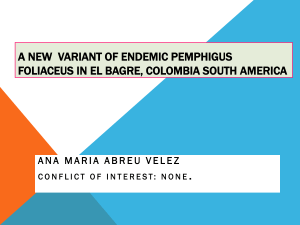

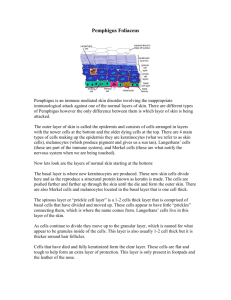
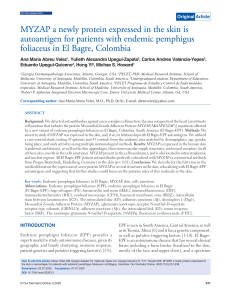

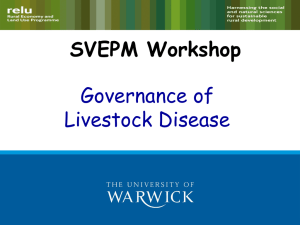
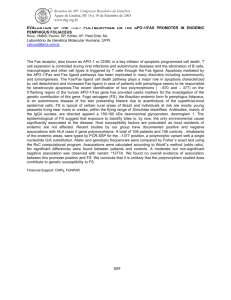
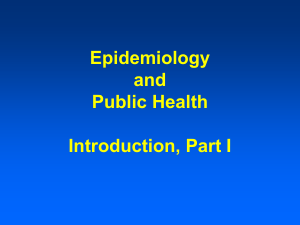

![Rare two cases of EPF.1540-9740.2004.03514.x[1]](http://s3.studylib.net/store/data/025161930_1-50863f89644b49f4e0ab2775c1774ff6-300x300.png)
